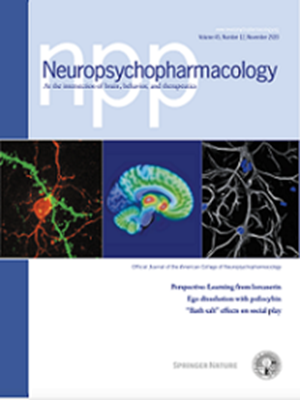Distinct subpopulations of parvalbumin neurons participating in divergent prefrontal functions
IF 6.6
1区 医学
Q1 NEUROSCIENCES
引用次数: 0
Abstract
Prefrontal parvalbumin (PV) neurons play crucial roles in various distinct functions, while malfunction of PV-neurons also has critical contributions to various brain diseases, including both psychiatric and neurodegenerative disorders. However, whether the prefrontal cortex (PFC) PV-neurons participating in these functions and malfunctions are distinct subpopulations is not well understood. This question is important for a better understanding of both the basic properties/function of PV-neurons and inhibitory neurons in general, and for potential comorbid occurrence of dysfunctions in disease settings. Here, we analyzed dorsomedial prefrontal cortex (dmPFC) PV-neurons participating in working memory, modulation of conditioned fear memory, and anxiety, regarding their relative localization, electrophysiological properties, and synaptic inputs. In addition, by using activity-dependent tagging method, we examined whether manipulating the dmPFC PV-neurons participating in one function may affect another function as a way to test for potential functional interactions between them. We found that: (1) one single group of dmPFC PV-neurons participating in the two forms of modulation of conditioned fear memory, based on their high overlap in localization and mutual functional interactions with each other. (2) dmPFC PV-neurons participating in fear memory modulation and anxiety are two different subpopulations, with unique electrophysiological properties. (3) dmPFC PV-neurons participating in working memory and fear memory modulation are two different subpopulations, with different synaptic and neuronal properties. These findings provide important insights into the organization of PV-neurons in the PFC and highlight the distinct and non-interacting nature of different PV-subpopulations in the PFC functional diversity.

参与不同前额叶功能的小白蛋白神经元的不同亚群。
前额小白蛋白(PV)神经元在各种不同的功能中起着至关重要的作用,而PV神经元的功能障碍也对各种脑部疾病,包括精神疾病和神经退行性疾病有重要贡献。然而,参与这些功能和故障的前额皮质pv神经元是否是不同的亚群尚不清楚。这个问题对于更好地理解pv神经元和抑制性神经元的基本特性/功能以及疾病环境中功能障碍的潜在合并症的发生非常重要。在这里,我们分析了背内侧前额叶皮层(dmPFC)中参与工作记忆、条理性恐惧记忆和焦虑调节的pv神经元,以及它们的相对定位、电生理特性和突触输入。此外,通过使用活动依赖的标记方法,我们研究了操纵dmPFC pv神经元参与一种功能是否会影响另一种功能,以此来测试它们之间潜在的功能相互作用。研究发现:(1)单组dmPFC pv神经元参与条件恐惧记忆的两种形式的调节,基于它们在定位上的高度重叠和相互功能的相互作用。(2)参与恐惧记忆调节和焦虑的dmPFC pv神经元是两个不同的亚群,具有独特的电生理特性。(3)参与工作记忆和恐惧记忆调节的dmPFC pv神经元是两个不同的亚群,具有不同的突触和神经元性质。这些发现为PFC中pv神经元的组织提供了重要的见解,并突出了PFC功能多样性中不同pv亚群的独特和非相互作用性质。
本文章由计算机程序翻译,如有差异,请以英文原文为准。
求助全文
约1分钟内获得全文
求助全文
来源期刊

Neuropsychopharmacology
医学-精神病学
CiteScore
15.00
自引率
2.60%
发文量
240
审稿时长
2 months
期刊介绍:
Neuropsychopharmacology is a reputable international scientific journal that serves as the official publication of the American College of Neuropsychopharmacology (ACNP). The journal's primary focus is on research that enhances our knowledge of the brain and behavior, with a particular emphasis on the molecular, cellular, physiological, and psychological aspects of substances that affect the central nervous system (CNS). It also aims to identify new molecular targets for the development of future drugs.
The journal prioritizes original research reports, but it also welcomes mini-reviews and perspectives, which are often solicited by the editorial office. These types of articles provide valuable insights and syntheses of current research trends and future directions in the field of neuroscience and pharmacology.
 求助内容:
求助内容: 应助结果提醒方式:
应助结果提醒方式:


